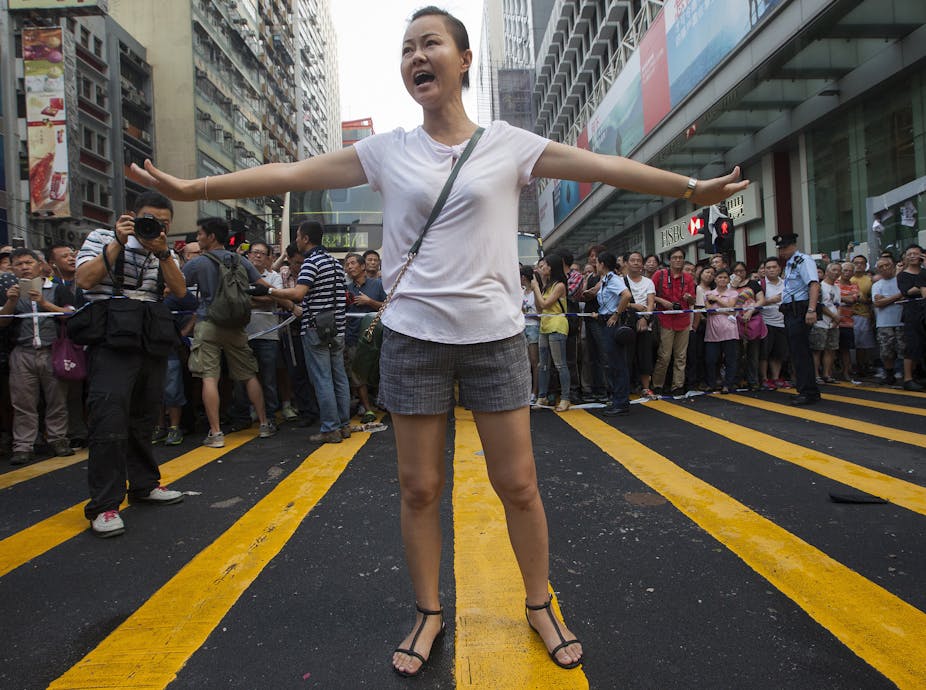Almost exactly a week after an infamous incident of police brutality against demonstrating students lit a fire under the Occupy Central campaign, the so-called umbrella movement is now facing another assault.
Hong Kong chief executive, CY Leung, had tried to diffuse the situation and avoid further escalating protests with a last-minute announcement of direct talks between the chief secretary, Carrie Lam, and representatives of the movement. But tensions continued to rise on the first day after the holiday break.
Initially, local residents and shop owners tried to remove street barricades in occupied areas, while a dwindling number of demonstrators tried hard to hold their ground. The arrival of larger groups of anti-Occupy activists (including masked young men) shouting insults and provoking brawls with protesters signalled the beginning of a different phase in the stand-off.
Several protesters were injured at the occupation site in Mong Kok, with incidents of sexual violence, threats and assaults on female protesters reported. The police were criticised for apparently failing to intervene in several instances.
On the face of it, the governments in Hong Kong and Beijing are reacting passively to the demonstrations since early this week. Both have already admitted that they are playing a waiting game, hoping that the movement will just fizzle out, and that Hong Kong’s non-protesting people will quickly feel inconvenienced. The unpleasant weather conditions and fatigue of many protesters have already significantly reduced the number of protesters.
So pressure on the government is easing – and no concessions, or only minor ones at best, should be expected at the moment. And at the same time, the authorities are pursuing more active strategies in their attempts to break the spirit and ruin the reputation of the umbrella movement.
Every trick in the book
The events of October 3 indicate that forces associated with the establishment are trying to tarnish the Occupy movement with an image of chaos and disorder. The pro-establishment media make references to “radicals” or “extremists” and the violence has turned the previously peaceful, harmonious and creative atmosphere into a hostile one, deterring citizens from joining in.
To make matters worse, triad members have seemingly been deployed and are acting as agents provocateurs to cause further violence – which could be used as a pretext for a forceful crackdown.
Meanwhile, pro-establishment lawmakers and anti-Occupy forces are united in their show of support for the government and the police force. So far, no pro-establishment figures have broken ranks. Unlike what happened in 2003, when James Tien’s defection led to the shelving of an anti-subversion law, relative moderates and senior figures from the pro-establishment camp have been very careful in their public remarks. They have merely called for calm and some form of negotiations.
Most of all, the authorities know the value of splitting your enemy.
Divide and conquer
Consultations have been used in Hong Kong in the past to divide the pan-democrats, as the in 2010 constitutional reform negotiations. The talks offered by Carrie Lam with movement representatives, now cancelled after the outbreak of violence, seemed to follow this strategy.
At the onset of the protest, she suggested an extended consultation period –but all post-1997 consultations on constitutional reform have been so biased, and their impact on the eventual outcome so minimal, that they have been virtually meaningless.
Indeed this has also to be said about key consultations on universal suffrage in the 1980s, famously rigged by the British colonial administration. If consultations are unlikely to bring about a breakthrough and the Hong Kong government believes it cannot deviate from the framework set out by the National People’s Congress, then the hidden agenda might indeed be to divide moderates from the more radical factions in the movement.
Given the extent of differences between the various groups of the movement, this might be entirely possible.
The initial student strike was organised by the Hong Kong Federation of Students and Scholarism, a more radical student organisation. The Occupy Central movement which joined later is composed of diverse groups devoted to principles of deliberative democracy, headed by senior scholars with little practical experience in social movement actions.
The student organisations do not agree on all their tactics and goals, and Occupy Central had originally planned only a relatively small-scale protest. They are joined by thousands of participants who wanted to show their solidarity with attacked students and fight for universal suffrage, but do not necessary belong to any of the groups.
It is therefore conceivable that government negotiations and possible acceptance of any form of agreement will cause internal conflict. It will require extraordinary management savvy by all leading figures of the umbrella movement to avoid this.
The coming days will show whether these strategies will actually work. Many commentators are pessimistic about the movement’s chances of success – but it would be presumptuous to make further forecasts at this point.
After all, no one predicted the umbrella movement in the first place. Hong Kong’s people have already surprised the world many times in just a few days – why should we expect them to stop now?

